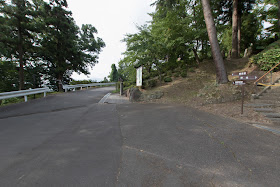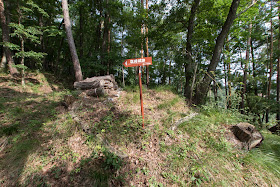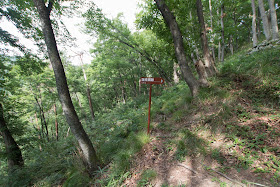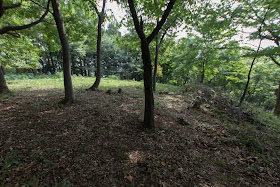Shiozaki Castle
-Castle securely protect backward-
Overview
Name: Shiozaki castle (Shiozaki-jo)
Alias:
Place: Shiozaki-Hase Shinonoi Nagano city, Nagano
Type: Mountain Castle
Built: 14th century?
Remaining remnants: Stone walls, clay walls and moats
Title:
Brief History
Shiozaki castle (塩崎城) is located at the edge of ridge spreads northeastward from Sasayama mountain, at the backside of Hase-dera temple at the west of Inariyama station. Hase-dera temple is a traditional temple continues over 1,000 years, and regarded as one of three major Hase-dera temple along with Hase-dera temple in Nara prefecture, the origin of Hase-dera temple, and Hase-dera temple at Kamakura city.
Castle site is above sheer slope of 200 meter height from front hillside area, but at backward there is huge flat space now used as golf course 100 meter higher from castle site. Of course this flat space is significantly processed on the construction of golf course, but it was a critical weak point of the castle where enemy troop could look down and ran down to the castle. Therefore the castle had secure defense facility at backward.
Castle near Inariyama town
Shiozaki castle is about 2 kilometer northward of Inariyama town, which was the largest posting town of Zenkoji Kaido road that separates from Seba town of Nakasendo road and runs Matsumoto basin northward across Sarugababa Toge pass, then enters Nagano basin then merged to Hokkoku Kaido road at Yashiro town at the opposite of Chikuma-gawa river.
As town place is a connecting point of the river transportation of Chikuma-gawa river and roads from Nagano basin, Matsumoto basin and Ueda basin, Inariyama town prospered as a hub of communication and transportation. Inariyama town declined due to the separation of railway but therefore still keeps many traditional merchant houses with stone built storages.
Precise year is not clear but Shiozaki castle might be built by Akazawa clan, which was the branch family of Ogasawara clan that served as the governor of Shinano province (Nagano prefecture) since the establishment of Muromachi Shogunate. Akazawa clan resided at Shiozaki castle, and let their retainer Kuwabara clan build Kosaka castle at the backward of former Inariyama town.
Setback of Ogasawara clan
In 1400, Nagahide Ogasawara (1366-1424), the leader of Ogasawara clan and was appointed as the governor of Shinano province, entered Nagano basin but faced the antipathy of local lords such as Murakami clan or Takanashi clan. Finally the alliance of local lords rose against Ogasawara clan, and broke it at the battle of Daito Gassen held near Shiozaki castle.
Broken Nagahide Ogasawara ran into Shiozaki castle held by relative, but suffered severe damage and could not stand it. Finally Nagahide Ogasawara left Shiozaki castle under coordination of deputy governor Oi clan and returned to Kyoto city. Akazawa clan also left Shiozaki castle then Murakami clan at the opposite of Chikuma-gawa river seized Shiozaki castle.
Over 30 years later in 1436, Masayasu Ogasawara (1376-1442), the younger brother of Nagahide Ogasawara, entered into Shinano province again, Masayasu Ogasawara broke Murakami clan then recovered Shiozaki castle then placed Akazawa clan again. Later Kuwabara clan which was the retainer of Akazawa clan overcame their master and became the lord of Shiozaki castle then renamed to Shiozaki clan.
Base of Takeda army
In the beginning of 16th century, Shiozaki clan subordinated to Murakami clan, which was the lord of Katsurao castle at the opposite of Chikuma-gawa river. Under Yoshikiyo Murakami (1501-1573), Murakami clan became a major local lord of the province held Ueda basin, Saku area and south part of Nagano basin, and Yashiro area at the opposite of Chikuma-gawa river was held by its important retainer Yashiro clan.
However, since 1540’s Shingen Takeda (1521-1573), the warlord of Kai province (Yamanashi prefecture), intruded into Shinano province and captured Suwa area and Saku area. Yoshikiyo Murakami resisted against Shingen Takeda and broke Takeda army twice at the battle of Uedahara in 1548 and Toishi castle in 1550.
But before the plot of Shingen, many retainers of Murakami clan turned to Takeda army. In 1553, Shiozaki clan turned to Takeda army along with Yashiro clan, and Yoshikiyo Murakami who was separated from Nagano basin finally left Katsurao castle and ran to Echigo province (Niigata prefecture).
Shingen Takeda next aimed to proceed toward Nagano basin used Shiozaki castle as one of the front line castles at the south of the basin. Shingen already seized Matsumoto basin, and from Matsumoto basin supply and soldiers might sent along with Saikawa river and crossed hills to Shiozaki castle. Takeda army repeatedly used Shiozaki castle but character of Takeda clan castle is not so seen at Shiozaki castle.
Structure of Shiozaki castle
Shiozaki castle spreads over the ridge straightly runs eastward. Central area of the castle is about 50 meter long square one, which has the large clay wall at western line. There is a basement which might be covered by stones on the clay wall and it might be used as a basement of main building. At southwest corner a line of stones is built downward but its intention is not clear.
At the north line of central area, low line of clay wall covered by stones spreads to secondary area. Secondary area is a rectangular one of 40 meter long and 30 meter wide and has a folded stone wall at southwest corner. Surrounding central area and secondary area many terraces were built toward east, the entrance of the castle.
As backside is connected to upper flat space, this part is securely protected by combination of huge three dry moats which have clay wall between them. To prevent traverse of side slope by enemy soldiers, these dry moats continues over 300 meter from the peak of the ridge to downward at both side slope. Total size of the castle is about 500 meter long and 400 meter wide.
Base of Uesugi clan
Shiozaki clan served as the vanguard of Takeda army for 30 years, but in 1582 Takeda clan was ruined by central ruler Nobunaga Oda (1534-1582). After the retreat of Oda army due to the loss of Nobunaga in the incident of Honnoji at that year, Kagekatsu Uesugi (1556-1623), the warlord of Echigo province proceeded to Nagano basin.
Kagekatsu Uesugi faced Hojo clan which was the lord of Sagami province (Kanagawa prefecture) and entered into Shinano province from Saku region, but before overwhelming army of Hojo clan Uesugi army could kept Nagano basin by the line of Shiozaki castle and Kaizu castle (Nagano prefecture).
Later Hojo army retreated from Shinano province and middle and south part of the province was held by Ieyasu Tokugawa (1543-1616), the warlord of Mikawa province (east half of Aichi prefecture). Yashiro clan and Shiozaki clan did not serve to Uesugi clan and became the retainer of Tokugawa clan.
Castle protected backward of Inariyama castle
Uesugi army built Inariyama castle at flat area of Inariyama town as a front line castle. But because of the terrain the enemy could go round to the backside of Inariyama castle passing mountains. Shiozaki castle might be kept to protect the backward of Inariyama castle, and as a watching place toward the inside of the valley.
Long dry moats at the backside of the castle are typical structure of castles built by Uesugi clan. Clearly shaped terraces and basement of tower shows the improvement of Shiozaki castle to the last period of Uesugi clan at Shinano province, until its movement to Aizu basin in 1598.
According to the list of retainer of Uesugi clan in 1593, the commander of Shiozaki castle was Shimizu clan which might have several hundred soldiers, and Inariyama castle was managed by Hoshina clan also having several hundred soldiers. Inariyama castle was directly managed by Uesugi clan as a major branch castle but Shiozaki castle might be held by Shimizu clan.
Afterward of castle
In 1598, Uesugi clan was moved to Aizu basin by Toyotomi government. Kawanakajima area became the direct territory of Toyotomi government, and small castles of the area were abolished. At this time Shiozaki castle and Inariyama castle might be abolished, and site of Inariyama castle turned to main lodge of Inariyama town. Under Shiozaki castle the building of Hase-dera temple lost in the battles gradually reconstructed.
Today no building remains but structure of the castle well remain on the mountain, even though backward is covered by bush. Looking the front side of the castle the scenery of Inariyama town is seen, and at backside combination of huge dry moats exists. This shows this castle structurally protected its backward toward backside mountain, and tactically protected the backward of Inariyama castle.
Access
20 minutes walk from JR East Shinonoi-sen line Inariyama station to Hase-dera temple. 30 minutes drive from Nagano Jidoshado Expressway Koshoku interchange to parking of Hase-dera temple. 30 minutes walk from inside of temple to hillside castle.
















































































































































No comments:
Post a Comment